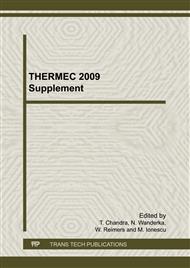p.545
p.551
p.556
p.562
p.568
p.574
p.580
p.586
p.592
Effects of Combined Zr and Mn Additions on Dispersoid Formation and Recrystallisation Behaviour of AA2198 Sheet
Abstract:
The present paper focuses on the influence of combined additions of Zr and Mn on the recrystallisation resistance of aluminium alloy 2198 sheet. Dual additions of these dispersoid forming elements have previously been reported to be beneficial for reducing recrystallisation during solution treatment, as they exhibit opposing microsegregation partitioning on solidification. Contrary to expectation, it was found that the addition of Mn, to a standard Zr-containing 2198 sheet material, reduced recrystallisation resistance. The reasons for this behaviour are explored by analysis of the morphology, size, chemistry, and distribution of the dispersoid families formed, as a function of the Mn and Zr level, traced back to the homogenisation stage.
Info:
Periodical:
Pages:
568-573
Citation:
Online since:
January 2010
Keywords:
Price:
Сopyright:
© 2010 Trans Tech Publications Ltd. All Rights Reserved
Share:
Citation:


